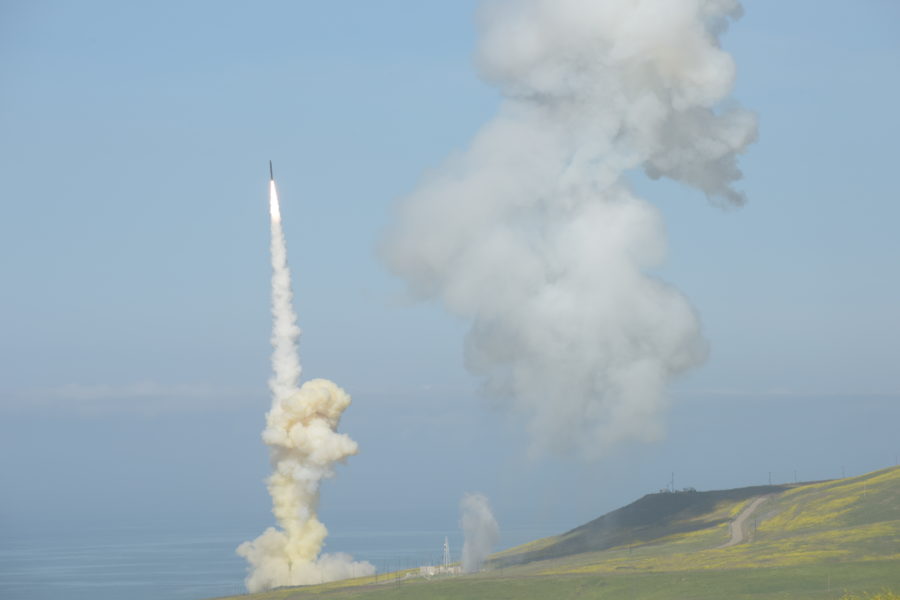The whole point of Russia’s war in Ukraine could be to drag the West into World War 3, said the executive director of Congress’ Task Force on National and Homeland Security.
Peter Pry, who is also director of Congress’ U.S. Nuclear Strategy Forum, spoke to retired Lt. Gen. David A. Deptula, dean of AFA’s Mitchell Institute for Aerospace Studies, during a livestreamed Nuclear Deterrence and Missile Defense Forum on April 21.
The discussion took place just one day after Russia’s military said it tested its new nuclear-capable Sarmat intercontinental ballistic missile, which, according to The Associated Press, Putin said would give the West pause. Pentagon Press Secretary John F. Kirby said April 20 that the test was “routine and not a surprise,” confirming that Russia had “properly notified the United States under its New START treaty obligations.”
“We did not deem the test to be a threat to the United States or its allies,” Kirby said.
During the Mitchell event, however, Pry questioned whether Russia’s President Vladimir Putin may have become emboldened by the direction of the U.S.’s nuclear posture over the past 30 years: Whereas the U.S. has positioned itself to deter a nuclear war, Russia has prepared to wage a surprise attack.
Pry was skeptical that Putin’s subordinates would balk at a nuclear strike. He said the U.S. should raise its readiness level in response to Russia’s doing so and argued that such a move could even spell the end of the war in Ukraine.
DEFCON 3
The involvement of three nuclear superpowers in the war in Ukraine—with China supporting Russia and the U.S. supplying arms to Ukraine—is “extremely alarming” and represents a “classical situation where we would have been concerned about the possibility of nuclear war,” Pry said.
“I think the administration and the Intelligence Community are either lying or have misconstrued the strategic situation,” Pry said, referring to dismissals of Russia’s heightened nuclear readiness level “as basically bluster or bluffing.
“And this has been used to justify keeping U.S. strategic nuclear forces at their lowest readiness level, DEFCON 5, which potentially makes them much more vulnerable to the surprise nuclear attack,” Pry said.
He doesn’t believe the U.S. would know an attack was about to happen.
Russia’s “ICBM command and control arrangement is such that we can’t see those forces mobilizing because they are on a condition the Russians call ‘constant combat readiness.’ All the time, they’re ready to launch … Twenty-four/seven, 365 days a year, Vladimir Putin could push a button and launch most of his nuclear weapons in just a few minutes without any advanced preparation.”
Pry said he thinks “the Intelligence Community is smart enough to know that. I hope they are. When I served in the CIA, we knew that the Russian strategic posture is very different from ours,” Pry said.
“Most Americans think of the Russian triad and the U.S. traid as basically the same, and they are not,” he continued. “Our strategic triad of bombers, missiles, and submarines is designed to deter nuclear war. Their nuclear triad of ballistic missiles, submarines, ICBMs, and bombers is designed to fight and win a nuclear war—particularly to achieve a surprise attack. To be able to beat us to the draw and strike us.
“That’s why, for example, most of their warheads [are for] ICBMs” which can carry up to 10 warheads, Pry said. On the other hand, the U.S. has the fewest warheads for its intercontinental ballistic missiles out of all three legs of the nuclear triad—400 total for its 400 Minuteman IIIs.
A “crippling blow to the United States” is possible by aiming just five nuclear warheads at the U.S., Pry said. “You could destroy the three bomber bases and the two ballistic missile submarine ports where most of our submarines are located on a day-to-day basis.”
Raising U.S. readiness could be a chance to end the war in Ukraine on peaceful terms, Pry argued.
“Going up at least to DEFCON 3 would put [U.S. forces] in a more survivable posture and then communicate to Moscow, ‘Look, we’re mobilizing our forces because you guys have mobilized your forces. Neither of us wants to get in a nuclear war, so stand down your forces, and we’ll stand down ours,’” he said,
Space-Based Interceptors
Of course, that solution relies on the assumption that Russia doesn’t want to get into a nuclear war, of which Pry isn’t convinced.
“When I look at what the Russians are doing, you know, it’s almost like they are taking steps that are calculated to be provocative to the West and to get us to intervene in that war,” Pry said. “I keep thinking of the Battle of Austerlitz in 1805—Napoleon’s greatest victory where he managed to get the combined armies of Austria and Russia to attack him by feigning weakness. [He] had whole regiments run away from the Russians to lure them into attacking him on the Austerlitz battlefield, and then he dropped the hammer.
“Does Russia want Ukraine to become the bloodlands of a World War 3—[to] have NATO and the United States come in there and then use [Putin’s] 10-to-1 advantage in tactical nuclear weapons as a final solution to the problem with NATO and the United States?” Pry said in reply to an audience question.
“I mean, we might already be there in terms of Russia taking advantage of the correlation of forces that flavors it in terms of nuclear firepower.”
The U.S.’s increase to 64 ground-based ICBM interceptors amount to “a joke” against foreign arsenals, Pry said: “North Korea even can challenge the 64 GBIs. We’ve got to get serious about that. I think the space-based defenses are the way of technologically moving forward to a place where we may be able to better defend the homeland.
“We’ve got a U.S. Space Force. It ought to be about that—building a missile shield for the United States. Not just about anti-satellite activity, which seems to be what its chief function is now.”
